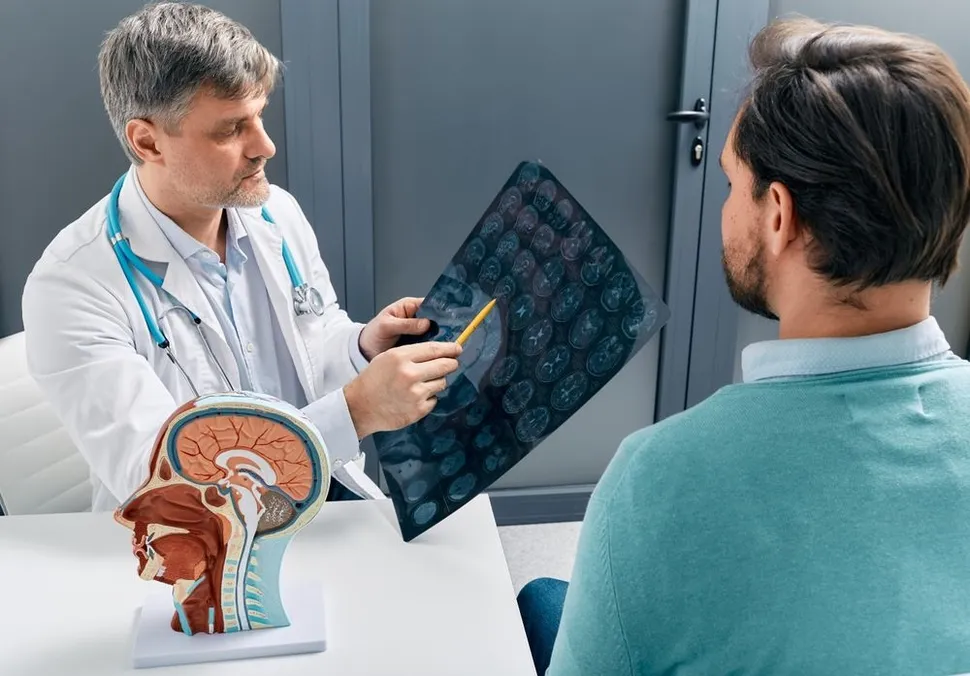Can DLBCL Spread to the Brain?

Diffuse large B-cell lymphoma (DLBCL) is an aggressive type of non-Hodgkin lymphoma. DLBCL can sometimes begin in or spread to the brain and spinal cord, referred to as the central nervous system (CNS). Exactly how or why this happens is not fully understood. Research suggests that it may be a combination of “push and pull” factors, meaning there are both factors within the CNS that help the tumor cells survive (pull factors) and factors outside the CNS that the tumor cells are unable to tolerate (push factors).
Around 5% of patients with DLBCL have CNS involvement at diagnosis, but it can also develop during or shortly after treatment. Patients who have a weakened immune system, either from other disorders or immunosuppressive treatment, have a higher risk of developing DLBCL with CNS involvement.
What Are the Differences Between Primary and Secondary CNS Lymphoma?
There are two main subtypes of CNS lymphoma:
- Primary CNS lymphoma
- Secondary CNS lymphoma.
Primary CNS lymphoma is a rare subtype of DLBCL. It involves the brain, eyes, spinal cord, or the membrane surrounding them without affecting other body parts. There are around 1,500 new cases in the United States every year, and the number of cases is higher in older patients, particularly patients over 75 years.
Secondary CNS lymphoma starts in other parts of the body and spreads to the CNS. Lymphoma might not be present in the CNS at diagnosis but rather appears in later stages when the disease relapses or stops responding to the treatment. The majority of cases of secondary CNS lymphoma are DLBCL.
What Is the Prognosis for CNS Lymphoma?
The prognosis for DLBCL involving the CNS is generally poor, with significantly worse outcomes than when the lymphoma is located in other areas of the body. Compared to other types of DLBCL, when it is present in the CNS, it is more difficult to cure, and there are fewer treatment options. However, the prognosis can differ from patient to patient, and several other factors may contribute, including:
- Age
- Functional impairment
- Biomarkers (certain proteins and enzymes)
- If there is any damage to the brain
- Initial effectiveness of therapy
What Are the Symptoms of CNS Lymphoma?
There are a number of symptoms of DLBCL involving the CNS, which may differ from the typical symptoms of DLBCL in other parts of the body, such as:
- Nausea and vomiting
- Seizures
- Headaches
- Arm or leg weakness
- Confusion
- Vision problems
- Hearing loss
Treatment of DLBCL with CNS Involvement
The treatment approach typically involves high-dose methotrexate-based chemotherapy as the cornerstone of therapy, especially for primary CNS lymphoma. This is often combined with other agents, such as cytarabine and rituximab, to enhance efficacy.
- For younger patients, dose-intensive consolidation therapies, including autologous stem cell transplantation, may be considered to improve outcomes.
- However, these intensive treatments are not suitable for all, particularly older patients, who may have fewer effective options.
In cases of secondary CNS lymphoma, where the CNS is involved at initial presentation or as a relapse, treatment strategies may mirror those for primary CNS lymphoma, but there might be particular challenges when trying to treat at the same time the lymphoma present in the CNS and the lymphoma on other parts of the body.
- Intrathecal chemotherapy, where drugs are administered directly into the cerebrospinal fluid, is also used to target CNS involvement.
Recent advances in understanding the molecular pathways of DLBCL have led to the exploration of targeted therapies and immunotherapy. Emerging targeted therapies for CNS lymphoma include Bruton’s tyrosine kinase (BTK) inhibitors like ibrutinib, phosphatidylinositol-3 kinase (PI3K) inhibitors, and immunomodulatory drugs. Additionally, immunotherapeutic strategies such as checkpoint inhibitors and chimeric antigen receptor T-cell (CAR-T) therapies are being explored in clinical trials, offering new alternatives with improved outcomes in these challenging cases.
Continue reading about the treatment options for DLBCL with CNS involvement.
What Are the Complications Associated with CNS Lymphoma?
There are several complications associated with DLBCL with CNS involvement, including both disease-related complications and treatment-related complications.
Patients with DLBCL with CNS involvement may receive whole-brain radiotherapy, which can cause neurological issues, particularly in patients aged over 60 years. These complications include difficulty walking, memory loss, and inability to control the bladder. Some patients experience post-traumatic stress disorder following treatment.
There is also an increased risk of developing a second cancer in long-term survivors of DLBCL with CNS involvement. Additionally, patients may experience complications as a result of radiation therapy, chemotherapy, or immunotherapy.
Patients who receive a transplant may have an increased risk of failure if immunosuppressive therapy is reduced or stopped.
Key Takeaways
- DLBCL can start in or spread to the central nervous system (CNS), which includes the brain and the spinal cord.
- Primary CNS lymphoma begins in the CNS, whereas secondary CNS lymphoma spreads to the CNS.
- The prognosis for DLBCL with CNS involvement is typically worse than other types of DLBCL.
- DLBCL with CNS involvement may have specific neurological symptoms.
- Doctors may advise more aggressive treatment regimens in these cases, although novel immunotherapies in clinical trials might offer better outcomes.
- Complications can arise due to treatment- or disease-related factors.
Stay up-to-date with the latest news in lymphoma treatment with HealthTree for DLBCL
Sources:
Diffuse large B-cell lymphoma (DLBCL) is an aggressive type of non-Hodgkin lymphoma. DLBCL can sometimes begin in or spread to the brain and spinal cord, referred to as the central nervous system (CNS). Exactly how or why this happens is not fully understood. Research suggests that it may be a combination of “push and pull” factors, meaning there are both factors within the CNS that help the tumor cells survive (pull factors) and factors outside the CNS that the tumor cells are unable to tolerate (push factors).
Around 5% of patients with DLBCL have CNS involvement at diagnosis, but it can also develop during or shortly after treatment. Patients who have a weakened immune system, either from other disorders or immunosuppressive treatment, have a higher risk of developing DLBCL with CNS involvement.
What Are the Differences Between Primary and Secondary CNS Lymphoma?
There are two main subtypes of CNS lymphoma:
- Primary CNS lymphoma
- Secondary CNS lymphoma.
Primary CNS lymphoma is a rare subtype of DLBCL. It involves the brain, eyes, spinal cord, or the membrane surrounding them without affecting other body parts. There are around 1,500 new cases in the United States every year, and the number of cases is higher in older patients, particularly patients over 75 years.
Secondary CNS lymphoma starts in other parts of the body and spreads to the CNS. Lymphoma might not be present in the CNS at diagnosis but rather appears in later stages when the disease relapses or stops responding to the treatment. The majority of cases of secondary CNS lymphoma are DLBCL.
What Is the Prognosis for CNS Lymphoma?
The prognosis for DLBCL involving the CNS is generally poor, with significantly worse outcomes than when the lymphoma is located in other areas of the body. Compared to other types of DLBCL, when it is present in the CNS, it is more difficult to cure, and there are fewer treatment options. However, the prognosis can differ from patient to patient, and several other factors may contribute, including:
- Age
- Functional impairment
- Biomarkers (certain proteins and enzymes)
- If there is any damage to the brain
- Initial effectiveness of therapy
What Are the Symptoms of CNS Lymphoma?
There are a number of symptoms of DLBCL involving the CNS, which may differ from the typical symptoms of DLBCL in other parts of the body, such as:
- Nausea and vomiting
- Seizures
- Headaches
- Arm or leg weakness
- Confusion
- Vision problems
- Hearing loss
Treatment of DLBCL with CNS Involvement
The treatment approach typically involves high-dose methotrexate-based chemotherapy as the cornerstone of therapy, especially for primary CNS lymphoma. This is often combined with other agents, such as cytarabine and rituximab, to enhance efficacy.
- For younger patients, dose-intensive consolidation therapies, including autologous stem cell transplantation, may be considered to improve outcomes.
- However, these intensive treatments are not suitable for all, particularly older patients, who may have fewer effective options.
In cases of secondary CNS lymphoma, where the CNS is involved at initial presentation or as a relapse, treatment strategies may mirror those for primary CNS lymphoma, but there might be particular challenges when trying to treat at the same time the lymphoma present in the CNS and the lymphoma on other parts of the body.
- Intrathecal chemotherapy, where drugs are administered directly into the cerebrospinal fluid, is also used to target CNS involvement.
Recent advances in understanding the molecular pathways of DLBCL have led to the exploration of targeted therapies and immunotherapy. Emerging targeted therapies for CNS lymphoma include Bruton’s tyrosine kinase (BTK) inhibitors like ibrutinib, phosphatidylinositol-3 kinase (PI3K) inhibitors, and immunomodulatory drugs. Additionally, immunotherapeutic strategies such as checkpoint inhibitors and chimeric antigen receptor T-cell (CAR-T) therapies are being explored in clinical trials, offering new alternatives with improved outcomes in these challenging cases.
Continue reading about the treatment options for DLBCL with CNS involvement.
What Are the Complications Associated with CNS Lymphoma?
There are several complications associated with DLBCL with CNS involvement, including both disease-related complications and treatment-related complications.
Patients with DLBCL with CNS involvement may receive whole-brain radiotherapy, which can cause neurological issues, particularly in patients aged over 60 years. These complications include difficulty walking, memory loss, and inability to control the bladder. Some patients experience post-traumatic stress disorder following treatment.
There is also an increased risk of developing a second cancer in long-term survivors of DLBCL with CNS involvement. Additionally, patients may experience complications as a result of radiation therapy, chemotherapy, or immunotherapy.
Patients who receive a transplant may have an increased risk of failure if immunosuppressive therapy is reduced or stopped.
Key Takeaways
- DLBCL can start in or spread to the central nervous system (CNS), which includes the brain and the spinal cord.
- Primary CNS lymphoma begins in the CNS, whereas secondary CNS lymphoma spreads to the CNS.
- The prognosis for DLBCL with CNS involvement is typically worse than other types of DLBCL.
- DLBCL with CNS involvement may have specific neurological symptoms.
- Doctors may advise more aggressive treatment regimens in these cases, although novel immunotherapies in clinical trials might offer better outcomes.
- Complications can arise due to treatment- or disease-related factors.
Stay up-to-date with the latest news in lymphoma treatment with HealthTree for DLBCL
Sources:

about the author
Dylan Barrett
Dylan is a freelance medical writer based in Cork, Ireland. He previously worked in independent medical education while living in London and is now collaborating with HealthTree to develop resources for blood cancer patients. His background is in genetics, and he has a passion for innovative scientific research. In his spare time, he enjoys sports, traveling, and spending time with his family and friends.
More on Navigating Your Health
Get the latest thought leadership on your Lymphoma delivered straight to your inbox
Subscribe to the weekly newsletter for news, stories, clinical trial updates, and helpful resources and events with cancer experts.







